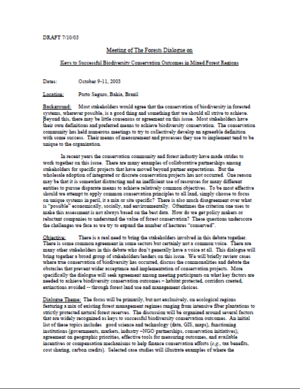Keys to Successful Biodiversity Conservation Outcomes in Mixed Forest Regions
Most stakeholders would agree that the conservation of biodiversity in forested
systems, wherever possible, is a good thing and something that we should all strive to achieve.
Beyond this, there may be little consensus or agreement on this issue. Most stakeholders have
their own definitions and preferred means to achieve biodiversity conservation. The conservation
community has held numerous meetings to try to collectively develop an agreeable definition
with some success. Their means of measurement and processes they use to implement tend to be
unique to the organization.
In recent years the conservation community and forest industry have made strides to
work together on this issue. There are many examples of collaborative partnerships among
stakeholders for specific projects that have moved beyond partner expectations. But the
wholesale adoption of integrated or discrete conservation projects has not occurred. One reason
may be that it is somewhat distracting and an inefficient use of resources for many different
entities to pursue disparate means to achieve relatively common objectives. To be most effective
should we attempt to apply common conservation principles to all land, simply choose to focus
on unique systems in peril, it a mix or site specific? There is also much disagreement over what
is “possible” economically, socially, and environmentally. Oftentimes the criterion one uses to
make this assessment is not always based on the best data. How do we get policy makers or
reluctant companies to understand the value of forest conservation? These questions underscore
the challenges we face as we try to expand the number of hectares “conserved”.

